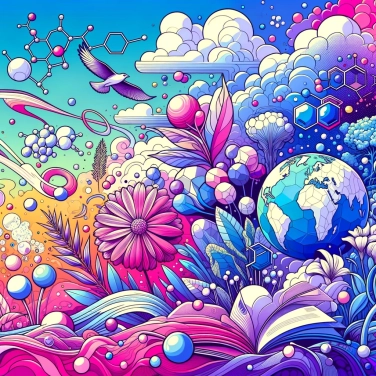The sky appears blue from the Earth due to the scattering of sunlight in the Earth's atmosphere. However, from space, the sky appears black because there is no atmosphere present to scatter the light and therefore the light cannot be dispersed.

The sky is blue thanks to Rayleigh scattering, a physical phenomenon that relates to how sunlight travels through the air. Sunlight contains all visible colors, but not all colors pass through our atmosphere with the same ease. Blue and violet colors are scattered very efficiently, bouncing off air molecules much more easily than red or orange. So even though the scattered light is mostly violet and blue, our eyes primarily perceive blue, as they are more sensitive to this color. That’s why, from Earth, we see the sky as blue almost all the time.
The atmosphere acts as a true filter. It is composed of air molecules (mainly nitrogen and oxygen) that scatter sunlight. This is precisely what is called Rayleigh scattering: it mainly affects the blue rays of the light spectrum, scattering them all around the sky. Other colors like red or orange pass through more easily with less scattering, except at dawn or dusk when their path through the air is longer. Without this gas layer above our heads, like on the Moon, we would simply see a completely black sky, even during the day, with the Sun shining in the middle. It is truly thanks to our little protective layer of atmosphere that we can admire this familiar blue every day.
From space, you can see directly into the void, with no atmosphere to scatter sunlight. However, this spatial vacuum hardly scatters light because it contains very few particles. As a result, there is nothing to reflect or disperse the light rays to your eyes, so there is no colorful glow to illuminate your view, hence this deep black. Essentially, from space, you only observe the direct light from stars or planets: between them, it's just an immense dark void. No Rayleigh effect, no scattering: the beauty of the blue sky becomes total black.
Our eye captures light through sensitive cells called cones and rods. Cones mainly manage daytime vision and detect colors, while rods ensure vision in darkness, without distinguishing colors well. During the day, it is mainly the cones that are active: they perceive colors at short wavelengths like blue better. As a result, the sky appears bright blue to us. In contrast, in the darkness of space, no diffuse light reaches our eyes directly, so our sensitive cells capture very little light information: this explains why we see the space sky as completely black. Essentially, our eyes clearly influence how we perceive the color of the sky depending on the lighting environment we are in.
During the Apollo missions, astronauts reported that the sky seen from the lunar surface was completely black, despite the bright Sun in the sky, simply because the Moon has no atmosphere. On Earth, at the top of high mountains like Everest, the sky also appears darker blue than at lower altitudes: there are fewer air molecules to scatter sunlight. This is also why when a plane ascends very high into the stratosphere, beyond 20 kilometers in altitude, the sky gradually becomes darker. From the International Space Station (ISS), astronauts see the Earth with a beautiful blue rim on the horizon, but when looking directly into space, everything is completely black, as there is nothing to scatter the light.
Did you know that the actual color of the Sun observed from space is white? From Earth, it appears yellow due to the atmospheric scattering of sunlight.
Did you know that the phenomenon of Rayleigh scattering, which is responsible for the blue color of the sky, is also the same phenomenon that explains the blue color of the human iris when it contains little pigment?
Did you know that on the Moon, the sky always appears black even in broad daylight, because it has no atmosphere to scatter light like Earth's does?
Did you know that on planets with a very different atmosphere, like Mars, the sky often appears pink during the day and bluish at sunset, exactly the opposite of Earth?
No, if the Earth's atmosphere were to suddenly disappear, the sky would immediately appear black, even in broad daylight. Sunlight would no longer be scattered by air molecules, and there would be no optical phenomenon to give it a blue color.
Astronauts perceive colors differently in space due to the lack of atmosphere. When they look towards Earth or other planets, they actually see the true colors of the surfaces or clouds reflecting sunlight. However, when they look directly into space, they do not see the richly dispersed colors that we perceive from Earth. Therefore, their images of the sky are generally black with bright stars.
The color of the sky depends on the chemical composition and thickness of the atmosphere. On Mars, for example, the atmosphere is thin and filled with dust, giving the sky a reddish or pinkish hue. On Venus, the dense atmosphere, primarily composed of carbon dioxide and sulfuric acid, tends to give a yellowish appearance. Thus, the Earth’s blue sky is not universal in the solar system.
Although stars continuously emit light, space appears black primarily due to its vastness: stellar content is distributed sparsely within it. Thus, most directly observed regions do not contain bright sources that are close enough or powerful enough to significantly illuminate the dark background of space.
At sunset, the light must pass through a greater thickness of the Earth's atmosphere. Short wavelengths (blue and violet) are heavily scattered by diffusion, mainly allowing longer wavelengths like orange or red to pass through, giving the sky its characteristic hue.

0% of respondents passed this quiz completely!
Question 1/6